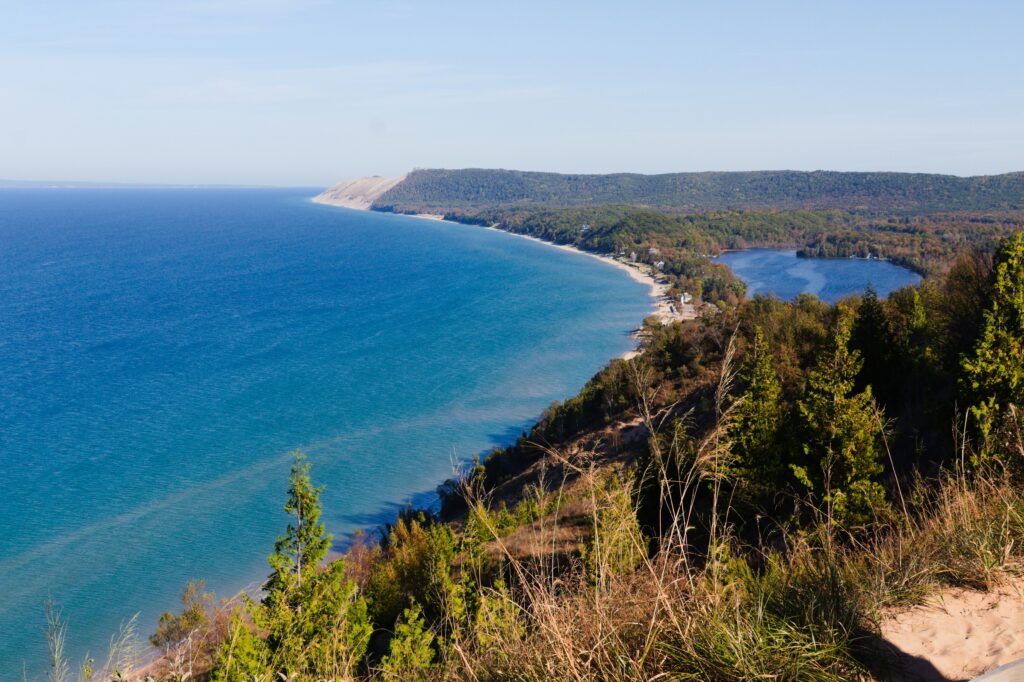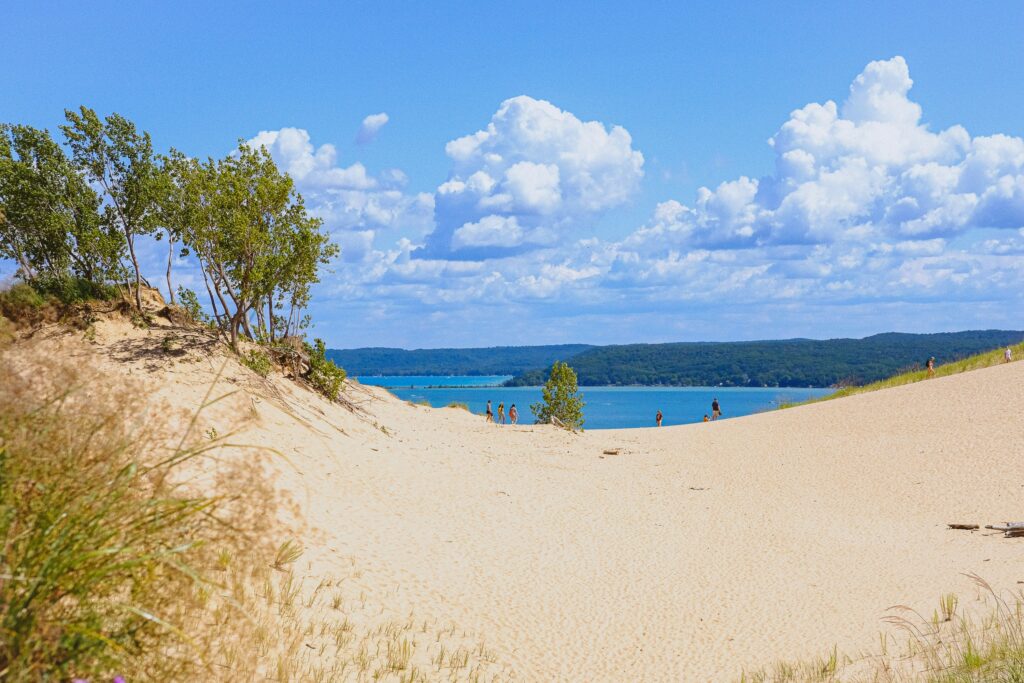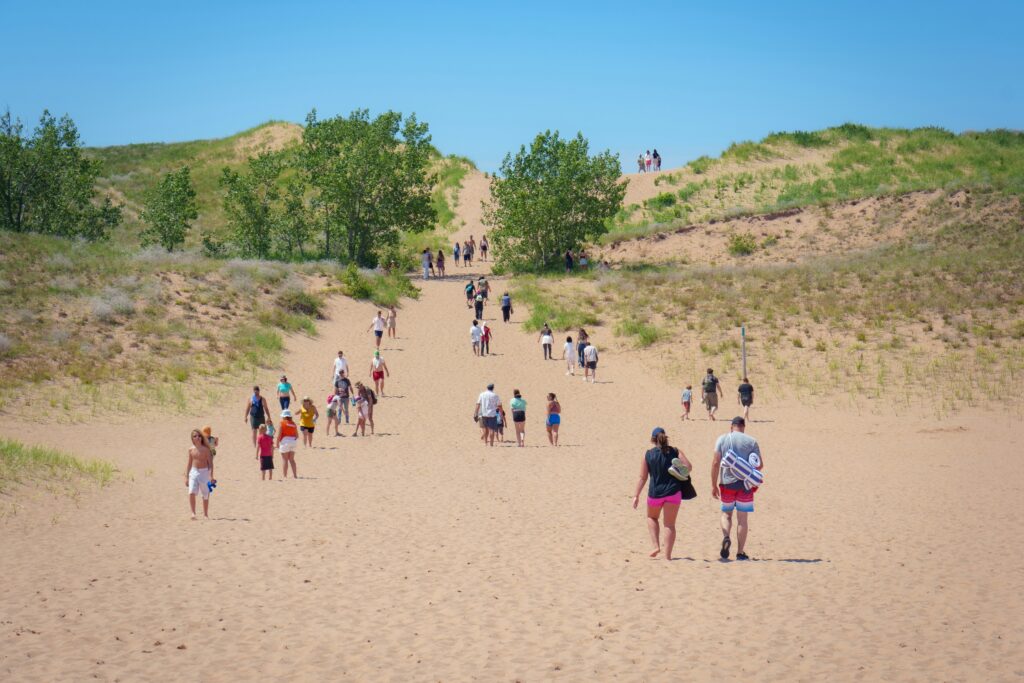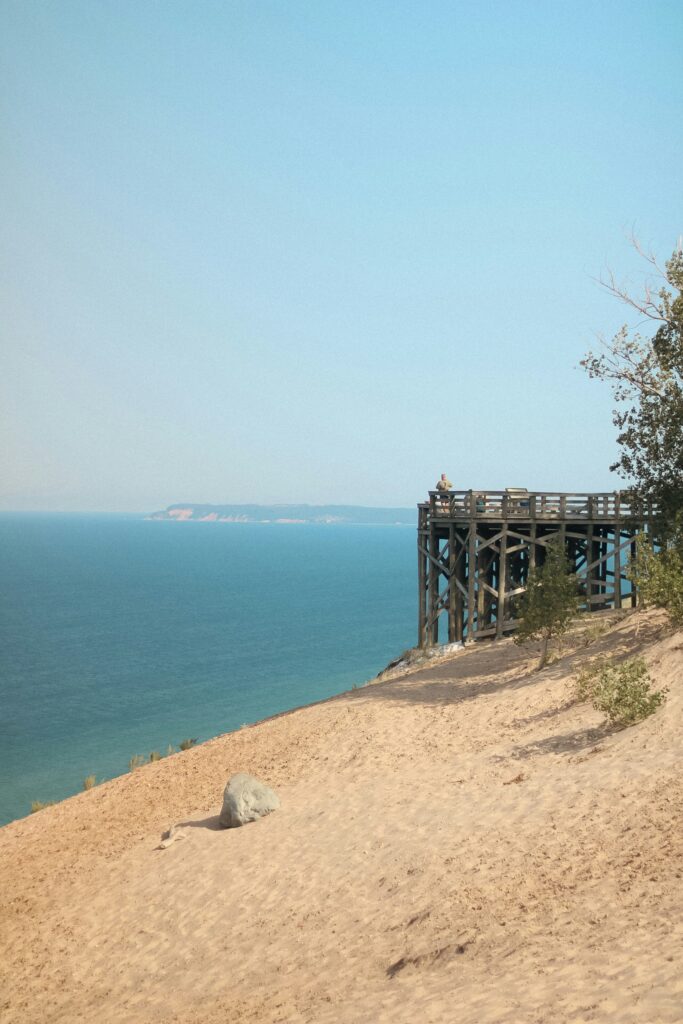Sleeping Bear Dunes National Lakeshore

Sleeping Bear Dunes National Lakeshore is a stunning park located along the northwest coast of the Lower Peninsula Michigan. The impressively large national lakeshore spans 71,199 acres of protected Michigan wilderness and covers 35-miles of Lake Michigan shoreline. It features towering sand dunes, miles of pristine beaches, lush forests, and beautiful views of Lake Michigan. The park offers various outdoor activities such as hiking, swimming, national park camping, and wildlife watching. The most iconic attractions in this unforgettable national park are the towering sand dunes, some of which rise hundreds of feet above the lake. It’s a popular destination for nature lovers and outdoor enthusiasts alike.

Here are 5 features and landmarks of the national park that make it worth your next trip:
1. Massive Sand Dunes:
The sand dunes in Sleeping Bear Dunes National Lakeshore are iconic – the park is famous for its large and distinct sand dunes, including the dune at the Lake Michigan Overlook on the Pierce Stocking Scenic Drive, which rises 450 feet above Lake Michigan, offering astounding panoramic views of the area.
Another popular area in the park is the Dune Climb in Glen Arbor, MI where visitors enjoy the challenging climb atop the 284-foot tall tower of sand. Once at the top, take a rest for stunning views of Little Glen Lake to the east and more dunes to the west. To make a day of it, visitors can hike 3.5 miles from the Dune Climb to Lake Michigan on the Dunes Trail, for unmatched views of the lake. Note that the journey takes about 3-4 hours round trip, as the trail is all sand.
The sand dunes were formed over thousands of years through a combination of geological processes, including glacial activity, erosion, and wind deposition. As glaciers retreated, they left behind sand and sediment that was later shaped by wind and water. The dunes in the park include various types such as perched dunes, blowout dunes, and parabolic dunes.

2. Lake Michigan Shoreline:
The Lake Michigan shoreline played a significant role in the region’s history, serving as a transportation route for the Native American Tribes, traders and early settlers historical sites along the shoreline offer insights into the area’s maritime heritage. The park encompasses miles of pristine shoreline along Lake Michigan, with sandy beaches and clear waters ideal for swimming, sunbathing, and water sports. The Michigan shoreline is renowned for its spectacular sunsets, attracting visitors who gather along the beach to admire the sights and witness nature’s colourful exhibit as the sun dips below the horizon.
There are many great beaches to choose from in the Sleeping Bear area, but our personal favorite is Platte River Point Beach, where visitors can swim in the joining waters of Lake Michigan and Platte River!
3. Empire and Platte River Valleys:
The Empire and Platte River Valleys are two distinct but interconnected features within Sleeping Bear Dunes National Lakeshore. These valleys offer scenic drives and hiking trails, showcasing diverse ecosystems including forests, wetlands, and meadows.
Empire Valley: The Empire Valley is located near the town of Empire and is characterized by rolling hills, forests, and farmland. The valley serves as a gateway to the Sleeping Bear Dunes, with the park headquarters situated here. Visitors can explore hiking trails, scenic overlooks, and historical sites in the Empire Valley.
Platte River Valley: The Platte River Valley lies to the south of the Empire Valley and is named after the Platte River, which flows through it. This valley is renowned for its natural beauty, including lush forests, wetlands, and meandering waterways. The Platte River is popular for canoeing, kayaking, and fishing, with opportunities to spot wildlife such as bald eagles, ospreys, and river otters.
Interconnected Ecosystem: The Empire and Platte River Valleys are part of the larger ecosystem of Sleeping Bear Dunes National Lakeshore. The valleys provide habitat for a diverse array of plant and animal species, including rare and endangered species. Visitors can explore the interconnected trails and waterways that wind through both valleys, experiencing the unique landscapes and wildlife along the way. Both valleys offer numerous recreational opportunities for visitors to enjoy.

4. Glen Lake:
Located adjacent to Lake Michigan, Glen Lake is located within the boundaries of Sleeping Bear Dunes National Lakeshore in the northern Lower Peninsula of Michigan. Glen Lake is renowned for its stunning natural beauty, characterized by crystal-clear waters, sandy shores, and surrounded by rolling hills and forests. The lake’s tranquil setting provides a peaceful escape for visitors seeking relaxation and recreation.
Visitors can explore the lake’s shoreline, islands, and coves by boat, taking in the panoramic views of the surrounding landscape. Several hiking trails around Glen Lake offer opportunities for scenic walks and exploration. Trails meander through forests, along the shoreline, and provide access to overlooks with stunning views of the lake and surrounding area.
The area surrounding Glen Lake includes campgrounds where visitors can enjoy camping amidst the natural beauty of Sleeping Bear Dunes National Lakeshore. Camping near Glen Lake allows visitors to immerse themselves in the outdoor experience and enjoy easy access to the lake’s recreational opportunities.
5. Historic Sites:
Sleeping Bear Dunes National Lakeshore is home to several historic sites that offer insight into the area’s rich cultural and natural heritage. Some notable historic sites within the park include:
Port Oneida Rural Historic District: This district preserves the rural agricultural landscape of the late 19th and early 20th centuries. Visitors can explore historic farmsteads, barns, and other structures that provide a glimpse into the lives of early settlers in the region.
Glen Haven Historic Village: Located on the shore of Lake Michigan, Glen Haven was once a bustling port community and lumbering village. Today, it is home to several historic buildings, including a general store, blacksmith shop, and cannery museum, which showcase the area’s maritime and logging history.
South Manitou Island: South Manitou Island, part of the Sleeping Bear Dunes archipelago, is home to several historic sites, including the South Manitou Island Lighthouse and the remains of a U.S. Life-Saving Service station. Visitors can explore these sites and learn about the island’s role in maritime history.
North Manitou Island: North Manitou Island also features historic sites, including a lighthouse, shipwrecks, and remnants of Native American settlements. The island’s rugged terrain and pristine beaches provide a unique backdrop for exploring its cultural and natural history.
Empire Bluff Historic Logging Trail: This trail follows the route of an old logging railroad and provides interpretive signs highlighting the area’s logging history. Hikers can explore remnants of the logging era while enjoying panoramic views of Lake Michigan from Empire Bluff.
Sleeping Bear Dunes National Lakeshore offers a unique combination of natural beauty, recreational opportunities, and cultural heritage, making it a popular destination for outdoor enthusiasts and nature lovers.
